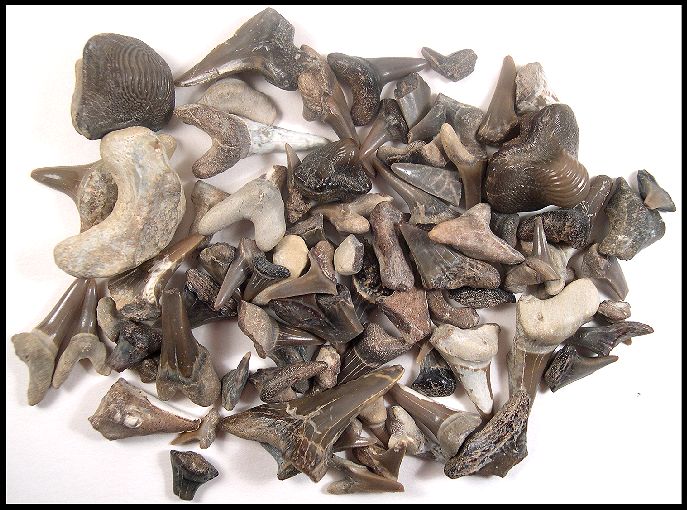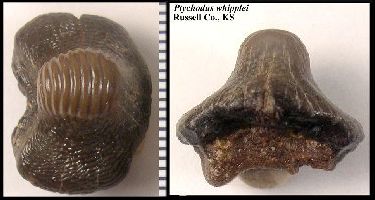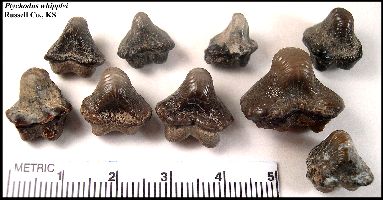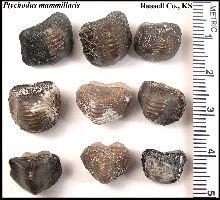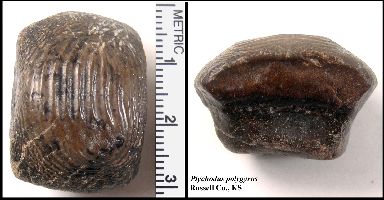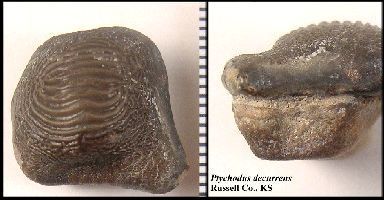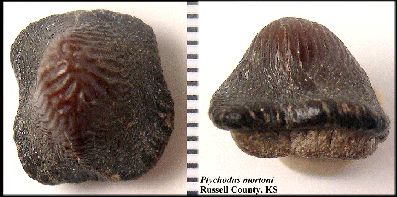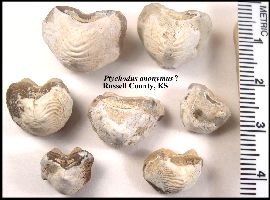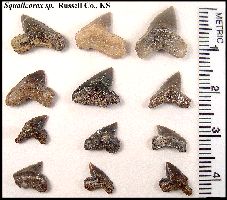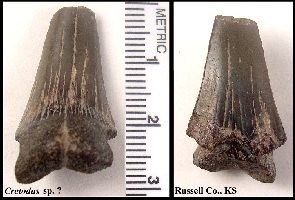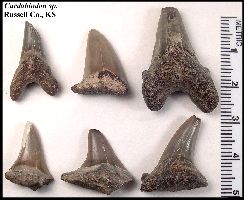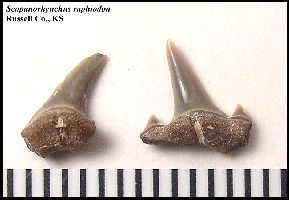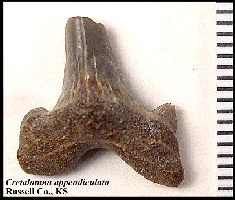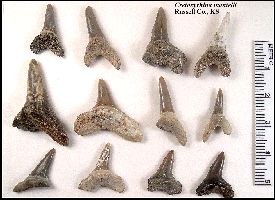Caggiano, T. and M. J. Everhart, 2003. A rare occurrence of the Late
Cretaceous ptychodontid shark, Ptychodus polygyrus Agassiz 1839, in the Smoky
Hill Chalk Member (Niobrara Formation) of western Kansas. Kansas Acad. Science Abstracts,
22:28.
Cope, E. D., 1875. The vertebrata of the Cretaceous formations of the
West. Report, U. S. Geol. Surv. Terr. (Hayden). 2:302 p, 57 pls.
Corrado, C. A., D. A. Wilhelm, K. Shimada, and M. J. Everhart.
2003. A new skeleton of the Late Cretaceous lamniform shark, Cretoxyrhina
mantelli, from western Kansas. Journal of Vertebrate Paleontology, Volume 23
(Supplement to Number 3): 43A.(Abstract)
Everhart, M. J. 2004. First record of the hybodont shark genus, “Polyacrodus”
sp., (Chondrichthyes; Polyacrodontidae) from the Kiowa Formation (Lower Cretaceous) of
McPherson County, Kansas. Kansas Academy of Science, Transactions 107(1/2): 39-43.
Everhart, M. J. and Caggiano, T. 2004.
An associated dentition and calcified vertebral centra of the Late Cretaceous
elasmobranch, Ptychodus anonymus Williston 1900. Paludicola, 4(4), p. 125-136.
Everhart, M. J., T. Caggiano and K. Shimada. 2003. Note on the
occurrence of five species of ptychodontid sharks from a single locality in the the Smoky
Hill Chalk (Late Cretaceous) of western Kansas. Kansas Acad. Sci. Abstracts, 22:29.
Everhart, M. J. and M. K. Darnell. 2004. Occurrence of Ptychodus mammillaris
(Elasmobranchii) in the Fairport Chalk Member of the Carlile Shale (Upper Cretaceous) of
Ellis County, Kansas. Kansas Academy of Science, Transactions 107(3-4):126-130.
Everhart, M. J. and P. A. Everhart, 1998. New data regarding the
feeding habits of the extinct lamniform shark, Cretoxyrhina mantelli, from the
Smoky Hill Chalk (upper Cretaceous) of western Kansas. Kansas Acad. Sci. Trans.
17:(Abstracts)33.
Everhart, M. J., P. A. Everhart and K. Ewell. 2004. A marine
ichthyofauna from the Upper Dakota Sandstone (Late Cretaceous). Abstracts of oral
presentations and posters, Joint Annual Meeting of the Kansas and Missouri Academies of
Science, p. 48.
Everhart, M. J., P. A. Everhart, E. M. Manning, and D. E. Hattin.
2003. A Middle Turonian marine fish fauna from the
Upper Blue Hill Shale Member, Carlile Shale, of north central Kansas. Journal of
Vertebrate Paleontology, Volume 23 (Supplement to Number 3): 49A.(Abstract)
Everhart, M. J., K. Shimada and K. Ewell. 2004. First record of the lamniform
shark genus, Johnlongia, from the Niobrara Chalk. Abstracts of oral presentations
and posters, Joint Annual Meeting of the Kansas and Missouri Academies of Science, p. 48.
Hamm, S. A. and M. J. Everhart, 1999. The occurrence of a rare
Ptychodontid shark from the Smoky Hill Chalk (upper Cretaceous) of Western Kansas. Kansas
Acad. Sci. Trans. 18(Abstracts):34.
Hamm, S. A. and K. Shimada. 2002. Associated tooth set of the late
Cretaceous lamniform shark, Scapanorhynchus raphiodon (Mitsukurinidae), from the
Niobrara Chalk of Western Kansas. Kansas Acad. Sci. Trans. 105(1-2)18-26.
Hamm, S. A., K. Shimada and M. J. Everhart, 2003. Three uncommon
lamniform sharks from the Smoky Hill Chalk (Upper Cretaceous) of western Kansas. Kansas
Academy of Science Abstracts, 22:30-31.
Hattin, D. E., 1962. Stratigraphy of the Carlile Shale (Upper
Cretaceous) in Kansas. State Geol. Surv. of Kansas, Bull. 156, (University of Kansas pub.)
155 p. 2 pl.
Hattin, D. E., 1965. Stratigraphy of the Graneros Shale (Upper
Cretaceous in central Kansas. Bulletin 178, Kansas Geological Survey, 83 pp.
Hattin, D. E., 1975. Stratigraphy and depositional environment of the
Greenhorn Limestone (Upper Cretaceous) of Kansas. Bulletin 209, Kansas Geological Survey,
128 pp.
Hattin, D. E. and C. T. Siemers, 1978. Upper Cretaceous stratigraphy
and depositional environments of western Kansas. Guidebook Series 3, AAPG/SEPM annual
meeting, Kansas Geological Survey, 55 pp. (Reprinted 1987)
Marcou, J., 1858. Geology of North America, with two reports on the
prairies of Arkansas and Texas, the Rocky Mountains of New Mexico, and the Sierra Nevada
of California, originally made for the United States Government. Pp. i-vi, 1-144, with 7.
(fig. and naming of P. whipplei)
Meyer, R. L. 1974. Late Cretaceous elasmobranchs from the Mississippi
and East Texas embayments of the Gulf Coastal Plain. Unpublished Doctoral dissertation,
Southern Methodist University, Dallas, 419 pp.
Mudge, B. F. 1866. First Annual Report on the Geology of Kansas. State
Printer. 57 pp. (first 15 pages only)
Mudge, B. F., 1874. Rare forms of fish in Kansas. Kansas Acad. Sci.
Trans. 3:121-122 (Agassizodus tooth plate and Protosphyraena)
Mudge, B. F. 1876. Notes on the Tertiary and Cretaceous periods of
Kansas. Bull. U.S. Geol. Surv. Terr. (Hayden), 2(3):211-221.
Mudge, B. F. 1877. Annual Report of the Committee on Geology, for the
year ending November 1, 1876. Kansas Acad. Sci. Trans., Ninth Annual Meeting, pp. 4-5.
(discovery of Uintacrinus socialis in Kansas, Pteranodon, sharks and
birds.)
Russell, D. A. 1988. A check list of North American marine cretaceous
vertebrates Including fresh water fishes, Occasional Paper of the Tyrrell Museum of
Palaeontology, (4):57.
Schultze, H.-P., J. D. Stewart, A. M. Neuner and R. W. Coldiron. 1982.
Type and figured specimens of fossil vertebrates in the collection of the University of
Kansas Museum of Natural History. Part I. Fossil fishes. Misc. Pub. Univ. Kansas
Mus. Nat. Hist. 73:53 pp.
Scott, R. W.
1970. Paleoecology and paleontology of the Lower
Cretaceous Kiowa Formation, Kansas. The University of Kansas Paleontological
Contributions, Article 52, 94 pp.
Shimada, K. 1993. Upper Cretaceous elasmobranchs from the Blue Hill
Shale Member of the Carlile Shale, Western Kansas. Kansas Academy of Science Abstracts,
12(78).
Shimada, K. 1993. Upper Cretaceous selachians from the Fort Hays
Limestone Member of the Niobrara Formation in Ellis County, Kansas. Kansas Academy of
Science Abstracts, 12(78).
Shimada, K. 1994. Paleobiology of the Late Cretaceous shark, Cretoxyrhina
mantelli (Lamniformes: Cretoxyrhinidae), from Kansas. Unpubl. Masters thesis. 169 pp.
Fort Hays State University.
Shimada,
K. 1996. Selachians from the Fort Hays Limestone Member of the Niobrara Chalk
(Upper Cretaceous), Ellis County, Kansas. Kansas Acad. Sci. Trans. 99(1-2):1-15.
Shimada, K. 1997a. Dentition of the late Cretaceous lamniform shark, Cretoxyrhina
mantelli, from the Niobrara Chalk of Kansas. Journ. Vert. Paleon. 17(2):269-279.
Shimada, K. 1997b. Shark-tooth-bearing coprolite from the Carlile
Shale (upper Cretaceous), Ellis County, Kansas. Kansas Acad. Sci. Trans. 100(3-4):133-138.
Shimada,
K. 1997c. Stratigraphic record of the late Cretaceous lamniform shark, Cretoxyrhina
mantelli (Agassiz), in Kansas. Kansas Acad. Sci. Trans. 100(3-4):139-149.
Shimada, K. 1997d. Gigantic lamnoid shark vertebra from the lower
Cretaceous Kiowa Shale of Kansas. Journ. Paleon. 71(3):522-524.
Shimada, K. 1997e. Paleoecological relationships of the late
Cretaceous lamniform shark, Cretoxyrhina mantelli (Agassiz). Journ. Paleon.
71(5):926-933.
Shimada,
K., 1997f. Periodic marker bands in vertebral centra of the late Cretaceous
lamniform shark, Cretoxyrhina mantelli. Copeia (1):233-235.
Shimada, K. 2005. Skeletal and dental anatomy of the Late Cretaceous
lamniform shark Cretalamna (= Cretolamna) appendiculata.
Journal of Vertebrate Paleontology 25 (Supplement to 3):114A-115A.
Shimada, K. and Cicimurri, D.J. 2005. Skeletal anatomy of the Late
Cretaceous shark, Squalicorax (Neoselachii: Anacoracidae). Paläontologische
Zeitschrift 79(2): 241-261.
Shimada, K., K. Ewell and M. J. Everhart. 2004. The first record of the
lamniform shark genus, Johnlongia, from the Niobrara Chalk (Upper Cretaceous,
western Kansas. Kansas Academy of Science, Transactions 107(3/4):131-135.
Shimada, K and M. J. Everhart. 2003. Ptychodus mammillaris
(Elasmobranchii) and Enchodus cf. E. schumardi (Teleostei) from the Fort
Hays Limestone Member of the Niobrara Chalk (Upper Cretaceous) in Ellis County,
Kansas. Kansas Academy of Science, Transactions 106(3-4):171-176.
Shimada, K. and M. J. Everhart. 2004.
Shark-bitten Xiphactinus audax (Teleostei: Ichthyodectiformes) from the Niobrara
Chalk (Upper Cretaceous) of Kansas. The Mosasaur 7, p. 35-39.
Shimada, K. and D. J. Martin. 1993. Upper Cretaceous selachians from
the basal Greenhorn Limestone in Russell Co., Kansas. Kansas Academy of Science Abstracts,
12(78).
Siverson, M. 1999. A new large lamniform shark from
the uppermost Gearle Siltstone (Cenomanian, Late Cretaceous) of Western Australia.
Transactions of the Royal Society of Edinburgh: Earth Sciences, 90:49-66.
Siverson, M. and J. Lindgren. 2005. Late Cretaceous sharks Cretoxyrhina
and Cardabiodon from Montana, USA. Acta Palaeontol. Pol. 50(2) 301-314.
Stewart, J. D. 1980. Reevaluation of the phylogenetic position of the
Ptychodontidae. Kansas Academy of Science, Transactions 83(3):154. (abstract)
Stewart, J. D. 1990. Niobrara Formation vertebrate stratigraphy, pages 19-30, In
Bennett, S. C. (ed.), Niobrara Chalk Excursion Guidebook, The University of Kansas
Museum of Natural History and the Kansas Geological Survey.
Welton, B. J. and R. F. Farish. 1993. The collectors guide to fossil
sharks and rays from the Cretaceous of Texas. Horton Printing Company, Dallas, 204 pp.
Williston, S. W. 1900. Cretaceous fishes
[of Kansas]. Selachians and Pycnodonts. Univ. Geol. Surv. Kansas VI pp. 237-256, with
pls.
